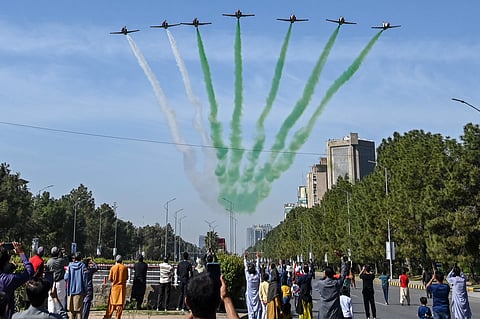Pakistan celebrates 85th National Day: Honouring the vision that shaped the nation
Country celebrates a legacy of unity, resilience and national pride

Islamabad: Pakistan Day is a spectacle of pride and patriotism, often starting with the early-morning military parade, watched live by many on TV or phone screens.
In Islamabad, the excitement reached a new height as fighter jets soar overhead, captivating the crowd with aerial stunts, and painting the sky with vibrant colours.
The day is filled with displays of national strength and unity, from flag-hoisting ceremonies to the ceremonial flypast.
March 23rd, 2025, marks the 85th celebration of Pakistan Day, a time for the nation to unite in honouring its heritage and reflecting on its journey.
Due to the holy month of Ramadan, this year’s celebrations featured a scaled-back parade at the Presidential Palace instead of the usual Parade Avenue in Islamabad.
Despite the smaller event, the spirit of the day remained unchanged.
A day of national celebrations
Pakistan Day is a time for reflection, with schools and communities hosting flag-hoisting ceremonies, cultural performances, and speeches that recognize the sacrifices made to establish the nation.
Recently, environmental initiatives have become a key part of the celebrations, with tree plantation drives organised by schools and youth groups.
These efforts symbolise a commitment to a greener future as the country’s youth take an active role in shaping a more sustainable tomorrow.
The day honours the founding fathers, with wreaths laid at the mausoleums of Muhammad Ali Jinnah and Allama Iqbal.
In Islamabad, the military parade is a hallmark of the day. Although scaled back this year, the parade featured a ceremonial flypast by the Pakistan Air Force.
March 23 is also the day when Pakistan honours national heroes and foreign dignitaries with top civilian awards.
Lahore Resolution of 1940
March 23rd commemorates the Lahore Resolution of 1940 — a pivotal moment in Pakistan’s history. On this day in 1940, the All India Muslim League (AIML), led by Muhammad Ali Jinnah, presented the Lahore Resolution – a call for Muslims to have a homeland where they could preserve their cultural, religious, and civilizational identity. This marked the first formal demand for a separate state for Muslims in British India.
Professor Sharif al Mujahid, a noted historian, compared the Lahore Resolution to the Magna Carta of 1215 — both monumental documents that reshaped the political landscape of their times. Just as the Magna Carta limited the powers of the monarchy and laid the foundation for modern constitutional law, the Lahore Resolution set in motion the demand for a separate homeland, which later became Pakistan.
The beginning of a nation
The Lahore Resolution of 1940 was more than just a political declaration — it was the blueprint for the birth of a nation. It was the fruition of the visionary ideas of Quaid-e-Azam Muhammad Ali Jinnah and Allama Muhammad Iqbal, who, in his famous Allahabad address in 1930, first recognised the need for a separate political entity for Muslims. This vision profoundly influenced Jinnah, whose unwavering determination, combined with his powerful speeches, helped galvanize the masses and laid the foundation for the Pakistan Movement. The Lahore Resolution served as the defining moment. Over the next seven years, this vision materialised with the creation of Pakistan on August 14, 1947, following the partition of British India.
Hasan Askari Rizvi, a renowned political analyst, called the Lahore Resolution “a turning point in the Muslim political struggle,” as it defined Muslims in British India as a distinct nation with the right to self-determination. This was a decisive shift from the idea of federalism and paved the way for Pakistan’s creation.
In 1947, Pakistan emerged as an independent nation but remained a dominion within the British Commonwealth. It was not until March 23, 1956, when Pakistan adopted its first constitution, that the country formally became the Islamic Republic of Pakistan. The journey toward full independence is symbolised by Minar-e-Pakistan, built between 1960 and 1968 in Lahore. Standing 70 meters tall, the monument marks the site where the Lahore Resolution was passed and serves as a symbol of Pakistan’s journey as a sovereign state.
Celebrating heritage and shaping future
Pakistan Resolution Day is more than just a celebration — it is a time to honour the past, reflect on the present, and look toward the future. From the grand celebrations in Islamabad to the quiet reflections of everyday Pakistanis, March 23rd is the day the nation stands united in its pride, remembering the struggles that led to its creation.
As Pakistan continues to grow and evolve, this day serves as a reminder of the power of unity, faith, and discipline – the guiding principles by Jinnah that continue to guide the nation’s journey toward progress and prosperity. While Pakistan has made significant progress, the road ahead is filled with both challenges and opportunities. And, the spirit of March 23, 1940, continues to inspire Pakistanis to move forward with resilience, unity, and hope for a brighter future.
Sign up for the Daily Briefing
Get the latest news and updates straight to your inbox



